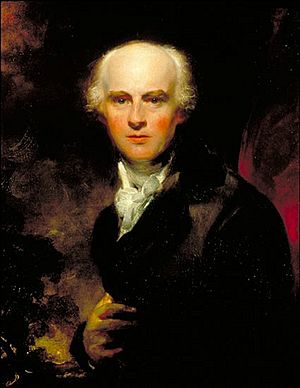Joseph Farington facts for kids

Joseph Farington (born November 21, 1747, died December 30, 1821) was an English artist. He was famous for his landscape paintings. He also kept a very detailed diary. This diary is now a super important source for historians. He was a member of the Royal Academy.
Contents
Early Life and Artistic Beginnings
Joseph Farington was born in Leigh, England. He was one of seven sons. His father was a church leader in Warrington and Leigh. Joseph's brother, George Farington, also became a painter.
Joseph started his art studies in London in 1763. He learned from a famous artist named Richard Wilson. Joseph quickly showed his talent. He won awards for his landscape drawings in 1764, 1765, and 1766. These awards were from the Society of Artists. He became a member of this society in 1765.
Joining the Royal Academy
In 1769, the Royal Academy was created. This was a big deal for artists. Joseph Farington joined it right away. He became an Associate of the Royal Academy (ARA) in 1783. Then, he became a full Royal Academician (RA) in 1785.
Joseph showed his art at the Academy's exhibitions every year. He did this until 1801. He was a very active member of the Academy. He helped decide where artworks would be hung. He also helped manage the affairs of other artists.
Travels and Artistic Inspiration
Joseph loved to draw landscapes. He spent time in the beautiful Lake District in England. Between 1776 and 1780, he made many drawings there. He even listed them in the order he thought they should be seen.
He also traveled in Europe. In 1793, he went to the Netherlands. He drew pictures for a report about a battle. In 1802, he visited Paris, France. He went with other famous artists like Benjamin West. In Paris, he saw old sculptures and Italian art. He also visited the studios of well-known French painters. After this trip, he painted less often.
It is hard to see all of Farington's paintings today. They are spread out in many collections. But he was very good at drawing accurate landscapes. These drawings were used in books of engravings. These books were popular with tourists. Tourists could not travel abroad much at the time.
In 1785, he published a book called Views of the Lakes of Cumberland and Westmorland. In 1794, he published a two-volume book. It was called History of the River Thames. This book had 76 aquatints. Aquatints are a type of printmaking. He also helped update an illustrated atlas. He added views of Cornwall to it in 1814.
His Important Diary
Joseph Farington started keeping a daily diary in 1793. He wrote in it almost every day until he died. This diary is incredibly valuable for historians. It tells us a lot about the art world in London. It also shares stories and details about artists of that time. It even explains how the Royal Academy worked.
Farington knew many important people. He knew factory owners and people from the East India Company. His wife's family gave him information about government plans. He attended major political trials. He also followed the campaign to end slavery. His diary covers many important events.
The diary eventually filled 16 volumes. It was kept by his family for a long time. In 1921, it was sold and published. It was first printed in a newspaper. Later, it was published as books between 1922 and 1928. Another edition came out between 1978 and 1984.
Personal Life and Later Years
Joseph Farington married Susan Mary Hamond in 1776. She was related to the Walpole family. They did not have any children. But Joseph was always interested in his brothers' children.
When his wife died in 1800, Joseph was very sad. He could not draw or paint for a while. His family and friends helped him recover.
Joseph Farington died on December 30, 1821. He was visiting his brother Robert in Lancashire. He fell down some stairs in a church.


